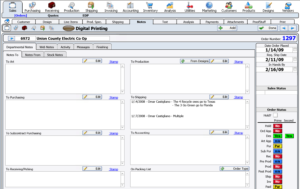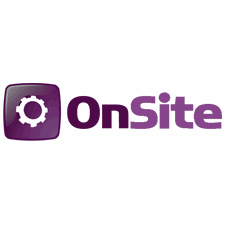 What is the one tool every shop needs to handle every step of the way between taking an order, producing it on the shop floor, shipping it and getting that order invoiced and paid? A shop operating system (also known as an ERP or Enterprise Resource Planning system).
What is the one tool every shop needs to handle every step of the way between taking an order, producing it on the shop floor, shipping it and getting that order invoiced and paid? A shop operating system (also known as an ERP or Enterprise Resource Planning system).
Most companies in the decorated apparel industry use a shop operating system. As most shops are too small to hire a full-time programmer to meet their system needs, using off-the-shelf business management technology is the way to go.
So which business software solution is for you? We’ve published a few articles on choosing a small business ERP system, as well as how to implement it. In this article, let’s explore why OnSite might be just the solution for you:
What’s Ahead for OnSite
OnSite manager software continues to evolve with at least one major upgrade every year. OnSite’s last major release in March 2015, which includes improved customer proofing, better touchscreen interfaces for the production floor and more accounting features. With over 750 customers actively using our product, most of our new features are a direct result of user suggestions.
The “next big thing” for later in 2015 will be ManageOrders.com, which is a “customer-facing” web portal. An end-user (the shop’s customer) can check on order status, see their designs, make payments, etc. Essentially, this will help streamline our customer’s operations because they can automate a lot of their customer service.
Tablet and Phone Support
Shopwork’s core product, OnSite, is accessible from a tablet using an RDP connection. It works great speed-wise and visually. Screen “real estate” on a phone makes it not as practical because everything is so small, but this will change as phone screens are getting bigger. Both of Shopwork’s web products, ProofStuff and ManageOrders, sense the device you are using and adjust the screen size (“Responsive” in web programming jargon).
Linking to Web Orders and Other Cloud-based Information
The OnSite ERP can take orders from any other website or program its built-in proprietary EDP interface. This is not a new feature, though; we’ve had it for years. Essentially, it allows a shop to use whatever product they want as an order-taking “front end,” and that order can then be processed and tracked on their main system.
OnSite Software Customizations
OnSite is very customizable for each company that uses it because there are so many types of companies and embellishments in our industry. For example, shop managers can set up OnSite to handle contract work (customer brings in the goods), subcontract work (sending out your production to someone else but buying the goods from another vendor), traditional production (buying the goods and then embellishing them) and traditional promotional product (buying both the finished good and the embellishment from a single vendor).
Users can customize icons used for orders, and what they name the machines, different departments, different “design types” — almost all the core system is customizable in this fashion. We have an online “repository” for Shopwork’s customers called ShopWorksCentral.com. It’s a website for three primary purposes:
- First, customers can reach and watch videos online for training.
- Second, Customers can reach documents, recorded webinars and other training materials when we release them.
- Third, when Shopworks release new versions, we post them here so customers can learn about the new features and download the upgrade.
What Challenges OnSite Can Solve
The biggest challenge that all of our customers have is that before buying our product, they are using four to six different systems or pieces of software to run their business. Typically they use forms for order entry, spreadsheets for purchasing, Excel for job quotes, magnet board or Excel for production scheduling, and QuickBooks or something else for accounting. This is inefficient and leads to lot of errors on orders, both of which limit how much their company can grow. Our challenge when switching a customer over to OnSite is for them to embrace the “integration” concept.
With OnSite, they enter information once and it travels through the company. It is what they need to grow, but they need to re-do procedures, employee training and sometimes look differently at the way they process orders. It is a lot of change management and we are honest with customers about the process and try to “shepherd” them through it.
One of the many advantages of an integrated system is that pricing, stock, and scheduling information is always right there and accessible to salespersons, production managers, shippers, and management. A sales rep can give a price upfront, secure a deposit
How OnSite Can Help Your Shop Become More Competitive
There are three main ways OnSite can help your shop become more competitive. The first is to cut the costs dramatically to process a sales order. Less labor per order means they can move more volume without increasing costs linearly.
The second is fewer errors on producing orders. OnSite keeps track of everything related to a sales order and all this information is available with the click of a mouse or swipe of a finger. Employees are less prone to make mistakes when paperwork is the same every time and not hand-written.
Lastly, Shopworks is a better end-user experience. Customers who have our software produce orders consistently and on-time and their customers appreciate that consistency.
Customer Access to Billing Information, Jobs on the Schedule or an Image Library
Customers can’t access Billing Information, Jobs on the Schedule or an Image Library in our current system but they will later in 2015 when we release our ManageOrders.com product.
What Sets Shopworks Apart
Shopworks culturally is from the industry and we understand it. That understanding translates to the software and even when you talk to our support staff. We understand very intimately what our customers do.
The platform we develop on is rapid development — three to 10 times faster than other platforms. This means we can deliver upgrades faster and cheaper than our competition, which is important when you talk about a changing industry like ours.
We are 100% committed to “integration” in our software. A lot of software companies think of integration more as a flat file export because with OnSite all the modules from marketing through accounting are all connected real-time because everything is in a single integrated package.
Where the Industry’s Headed
A lot of growth! The demand for embellished products will continue to increase and our industry will be a direct beneficiary of that. Technology will continue to evolve on the production floor as inventors continue to come up with new and interesting ways to get logos on things. This is the one aspect of our business that really makes it fun — the creative side. This is probably why we are all drawn to it.
The Biggest Daily Hurdle Shops Face – and How OnSite Helps
The biggest challenge is for the small-business owner to commit themselves to being exactly that: a business owner. This is especially true if they want to grow their business. A lot of people start a small business as an escape from the “regular” work world and they are doing themselves a disservice in the long run when not committing to the process. If you are going to own a business, embrace being an owner. Things you never thought of, like “systems,” “procedures” and “management,” are the key to your growth. Our manager software helps with this challenge by giving them a starting point for their company infrastructure. This is not all just for “big business;” these concepts are important for small operations as well. Our software is very configurable for different business types, but once it’s set up correctly, it will work whether you do $100,000, in sales volume per year up to $50 million. We have many customers across that sales volume spectrum and they all use the same software.
A Day in the Life of OnSite
OnSite’s production scheduling has a philosophy behind it: it’s almost impossible for a computer to handle 100% of scheduling production because there are so many variables. For example, in screen printing, not only are you looking for an open spot on a schedule, but you have to consider the number of heads, screen size, flash units available and maybe even who is the crew running a particular press to see if it is right for a job.
OnSite basically works this way. You set up all your equipment in OnSite and your production teams. Equipment has properties associated with them, including production rate. We recommend that all new customers set up a “scheduling machine” for each department as a best practice. For example, they would have a press setup in OnSite called “Schedule Screenprint” that would have average production rates associated with it. When a new job comes in it will automatically be scheduled for the “Scheduling Machine” based on the dates required by the person entering the sales order. You can set up the system to back this off by a few days if you want, avoid weekends, etc.
Procedurally, the production manager on a daily basis sees the jobs that have come in on the “Scheduling Machine” and moves them to a real machine based on their schedule. The benefit is that the manager can check every order before scheduling to make sure everything is there. For example, if the salesperson left off a key piece of information, the manager would be able to put the order on hold and send a message to the salesperson — all from within OnSite. Everything is documented on the order. This is all procedural and varies exactly in how it’s implemented from company to company.
If you’re interested in OnSite as a potential business software solution, discover more on our OnSite page and schedule a demo.
 A cloud-hosted ERP software for a small business is hosted offsite and is accessible from any computer through the Internet. This allows employees to use your system from any connected device, instead of just those computers in your office on which you’ve installed the decorated apparel ERP business software.
A cloud-hosted ERP software for a small business is hosted offsite and is accessible from any computer through the Internet. This allows employees to use your system from any connected device, instead of just those computers in your office on which you’ve installed the decorated apparel ERP business software.




